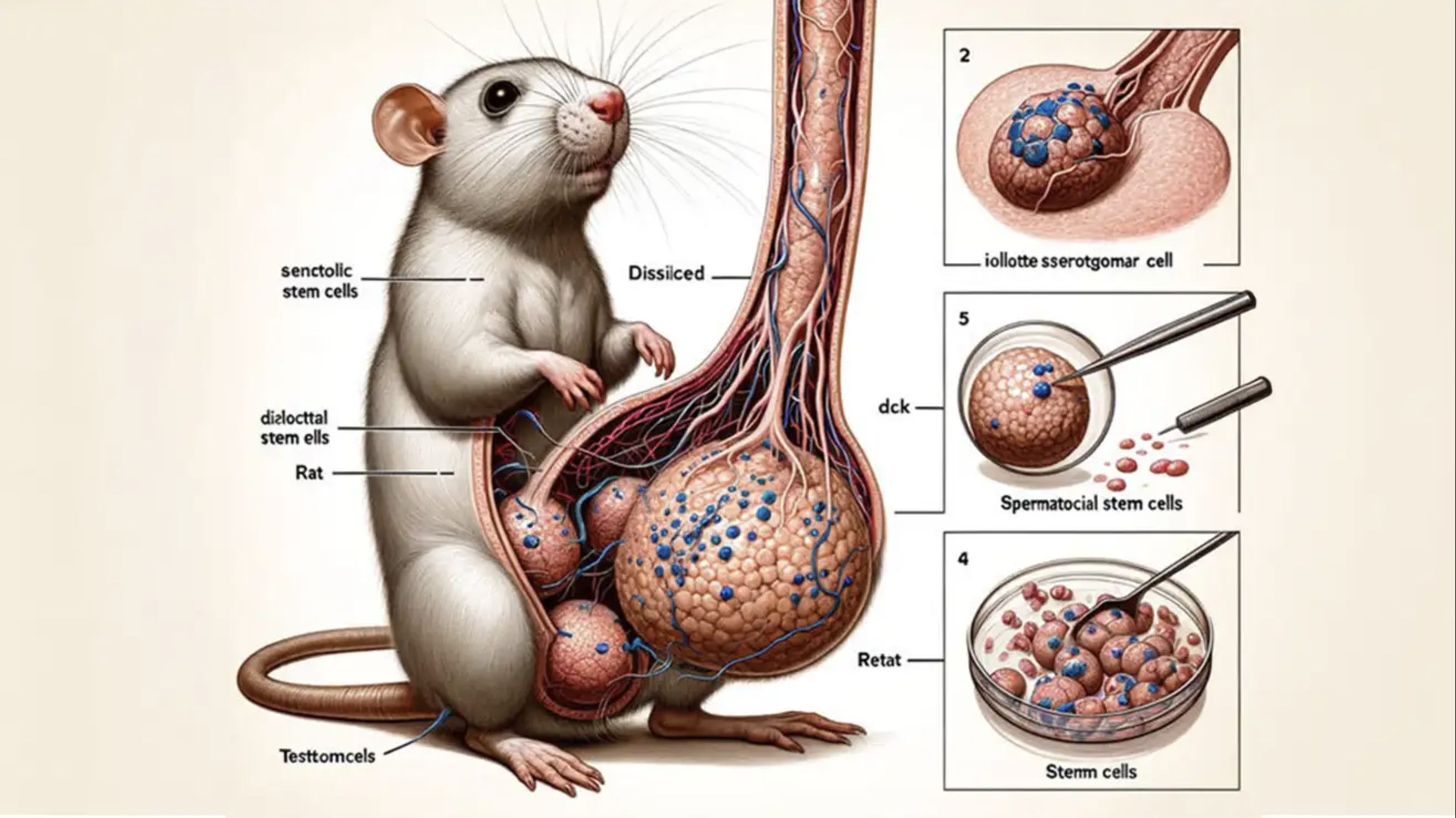Last week, a memorable image of rodent genitalia was featured in the scholarly publication Frontiers in Cell and Developmental Biology, within a research paper titled “Cellular roles of spermatogonial stem cells linked to the JAK/STAT signaling pathway.” Despite the serious title, the image itself was quite comical, portraying a white rat sitting upright and staring at an unusually large, split penis accompanied by not two but four testicles of different sizes. Even the rat seemed perplexed by the immense size of its genitalia, reminiscent of Gregor Samsa awakening to discover his modest appendage had morphed into a towering redwood tree reaching towards an unseen sky. The rat appeared unfazed by the overwhelming enormity of its scrotum, seemingly preoccupied with its phallus.
The scientific community reacted with shock not at the rat’s anatomy itself, as there is no shame in a rat having a penis, but rather at the ludicrously inaccurate depiction being published in a reputable scientific journal. While the world celebrates diversity in genitalia, there is no known rat whose entire body is overshadowed by its reproductive organs. The three authors of the paper, affiliated with Hong Hui Hospital and Jiaotong University in China, attributed the creation of the image to the AI art generator Midjourney. Upon closer inspection of the labels surrounding the rat, its reproductive organs, and the presumably extracted cells, the text was as indecipherable as Simlish. The rat was simply labeled “Rat,” while its testicles were termed “Testtomcels,” and its genitalia was described as “Dissilced.” Adjacent to the rat, the labels included “iollotte sserotgomar cell,” “Stemm cells,” “Retat,” and a succinct yet enigmatic “dck.”
The widespread outcry over this peculiar depiction of Retat and its genitalia, which even inspired several cookie recreations, prompted Frontiers to retract the paper by the week’s end, citing a failure to meet the journal’s editorial and scientific standards. For those interested in reading the original article, scientific integrity consultant Elisabeth Bik uploaded a PDF copy on her blog.
 Regestim? Seenimer! | Guo et al., Front. Cell Dev. Biol. 2024
Regestim? Seenimer! | Guo et al., Front. Cell Dev. Biol. 2024
While Retat’s genitalia captured the spotlight, each image in the paper crumbled upon even a cursory examination. For instance, Figure 2 purported to be a “Diagram of the JAK-STAT signaling pathway,” featuring perplexing labels such as “5 dimimeriom eme,” “Proprunization State protemns,” and “Sinkecter,” which one can only speculate to be a forum where enthusiasts discuss sinks. Figure 3 seemed to consist of a collage resembling haunted pizzas. Bik remarked on her blog that the paper exemplified the unfortunate reality of scientific journals, editors, and peer reviewers either naively accepting or possibly complicit in publishing AI-generated nonsensical content.
As a peer-reviewed scientific journal, Frontiers faced scrutiny regarding the acceptance of Retat’s genitalia. One of the paper’s reviewers, Jingbo Dai from Northwestern University, expressed that the responsibility for publishing such images ultimately falls on the publisher. Frontiers permits the use of generative AI technologies in its publications under certain conditions, including proper accreditation of the AI creator and ensuring content originality. The policy stipulates that human authors are accountable for verifying the factual accuracy of AI-generated content, raising the question of whether any AI-created image can indeed be factually precise. Would correcting “Testtomcels” to testicles and adjusting the rat’s anatomy to a more realistic depiction be sufficient? Would providing a scale bar for the rat’s penis enhance accuracy? Or perhaps depicting the rat in a state of terror at the sight of its exaggerated reproductive organs would render it more believable?
Retat has served as a stark reminder of the encroaching presence of AI-generated imagery infiltrating academic publications. While not all subpar AI images may be as blatantly deceptive as this exaggerated genitalia, Bik cautioned that more lifelike AI-generated visuals may have already seeped into scientific literature unnoticed. The broader concern lies in the potential infiltration of academic papers with inaccuracies derived from AI, highlighting a systemic issue where peer review standards may be lacking.
Furthermore, the proliferation of so-called predatory or questionable journals, operating on a pay-to-publish model without genuine peer review or editorial oversight, exacerbates the challenges in distinguishing reputable publications. These predatory journals, including those affiliated with MDPI and Frontiers, perpetuate confusion, propagate substandard scholarship, and deplete resources. Despite Frontiers ranking as the third-most cited publisher in 2022, suspicions of predatory practices persist, with authors of the retracted Retat article reportedly paying $3,295 for publication.
While the saga of Retat’s genitalia may have generated attention for a brief moment, the implications of pseudoscientific content extend beyond mere spectacle. Such misinformation poses a tangible threat to scientific integrity and those impacted by it. Instances like the publication questioning the HIV-AIDS link in Frontiers in Public Health or the anti-trans paper reviewed by biased researchers underscore the real-world consequences of unchecked pseudoscience in academic publishing.
As a science communicator, I’ve observed a notable increase in AI-generated images featured in press releases for new research papers, such as DALL-E’s abstract cosmic visuals accompanying a supernovae preprint or its depiction of a Paleoproterozoic evening in a microfossil study. Ironically, an article recounting the Retat debacle utilized a different unsettling AI-generated rat image as its main illustration. While these images may not directly appear in the scientific papers, they influence public perception and comprehension of the research, potentially overshadowing opportunities for human scientific illustrators to infuse creativity and perspective into scholarly visuals. The prevalence of AI-generated imagery underscores the evolving landscape of scientific communication, where visual representations play a crucial role in shaping scientific narratives.
In conclusion, the Retat incident serves as a cautionary tale highlighting the complexities of AI integration in academic publishing, the challenges posed by predatory journals, and the imperative to uphold scientific rigor and ethical standards in research dissemination.










